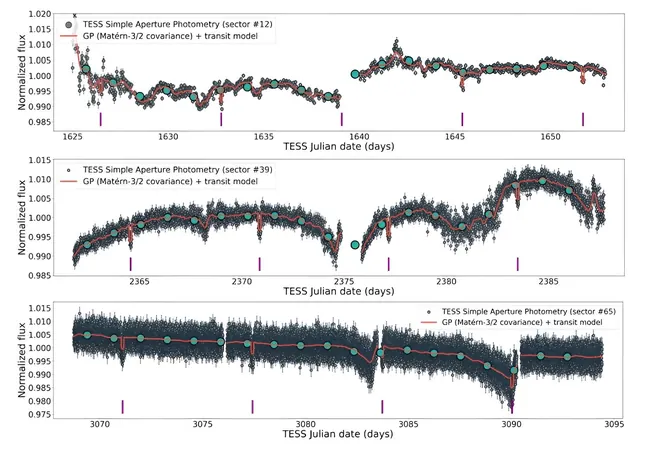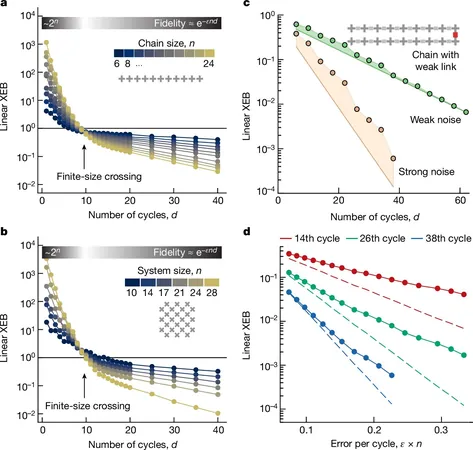
Astronomers Unveil Incredible New Super-Neptune Exoplanet: TOI-5005 b!
2024-10-02
Author: Mei
Astronomers Unveil Incredible New Super-Neptune Exoplanet: TOI-5005 b!
An exciting discovery has emerged from an international team of astronomers: a new super-Neptune exoplanet orbiting a solar-type star, officially named TOI-5005 b. This newly identified celestial body is about six times larger and more than 30 times the mass of Earth, making it a fascinating addition to the growing list of known exoplanets.
The breakthrough was reported in a paper published on September 26, using data from NASA's Transiting Exoplanets Survey Satellite (TESS), which is currently surveying approximately 200,000 of the brightest stars near our sun to identify transiting exoplanets. As of now, TESS has cataloged over 7,200 candidate exoplanets, known as TESS Objects of Interest (TOIs), and has confirmed 557 of those.
The research team, spearheaded by Amadeo Castro-González from the Astrobiology Center in Madrid, Spain, uncovered a distinct transit signal in the light curve of TOI-5005—located around 685 light years away and classified as a moderately bright solar-type star of spectral type G2V. The planetary nature of the signal was verified through several follow-up observations with ground-based instruments.
The characteristics of TOI-5005 b are astonishing. It boasts a radius of 6.25 Earth radii and a mass of 32.7 Earth masses, leading to a calculated density of 0.74 g/cm³. This substantial planet completes an orbit around its star every 6.31 days while lying at a distance of approximately 0.066 AU from the star. Remarkably, its estimated equilibrium temperature is a scorching 1,040 K.
Delving deeper into the planet's internal structure, the research indicates that TOI-5005 b has a core mass fraction of roughly 0.74 and an envelope metal mass fraction of about 0.08. The overall metal mass fraction stands at 0.76, which is slightly lower than that of Uranus and Neptune. These findings suggest that TOI-5005 b was formed through a process known as core accretion, a method theorized to prevail in the formation of many gas giants.
Interestingly, TOI-5005 b is classified within a unique and rare grouping of low-density Neptunes situated in what scientists refer to as the "Neptunian savanna." This area is characterized by a scarcity of Neptune-like exoplanets on short-period orbits, juxtaposed with a recently uncovered overdensity—termed a ridge—of Neptunes that have orbital periods ranging from 3 to 5 days.
What sets TOI-5005 b apart is its low density compared to its counterparts, typically showcasing densities above 1.0 g/cm³. The brightness of TOI-5005 also positions this system as an optimal target for future atmospheric studies and observations aimed at understanding the architecture of its orbits.
As astronomers eagerly probe deeper into the mysteries of the universe, the discovery of TOI-5005 b paves the way for new insights into planetary formation and the diversity of exoplanets out there. Stay tuned as we continue to monitor the developments from this exhilarating find!




 Brasil (PT)
Brasil (PT)
 Canada (EN)
Canada (EN)
 Chile (ES)
Chile (ES)
 España (ES)
España (ES)
 France (FR)
France (FR)
 Hong Kong (EN)
Hong Kong (EN)
 Italia (IT)
Italia (IT)
 日本 (JA)
日本 (JA)
 Magyarország (HU)
Magyarország (HU)
 Norge (NO)
Norge (NO)
 Polska (PL)
Polska (PL)
 Schweiz (DE)
Schweiz (DE)
 Singapore (EN)
Singapore (EN)
 Sverige (SV)
Sverige (SV)
 Suomi (FI)
Suomi (FI)
 Türkiye (TR)
Türkiye (TR)